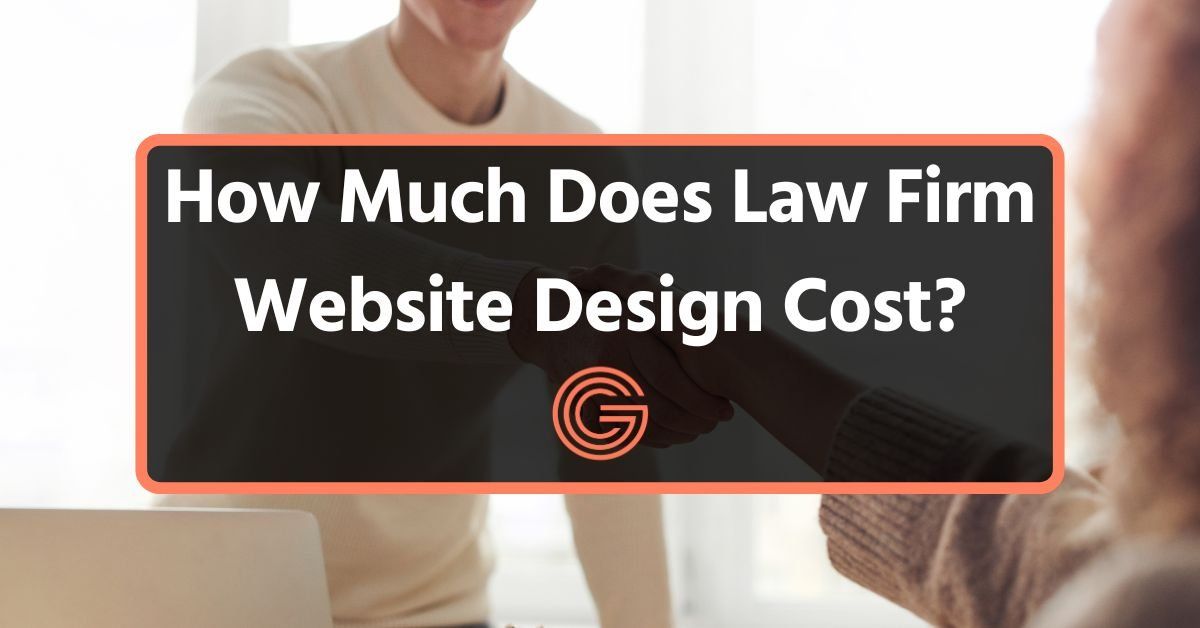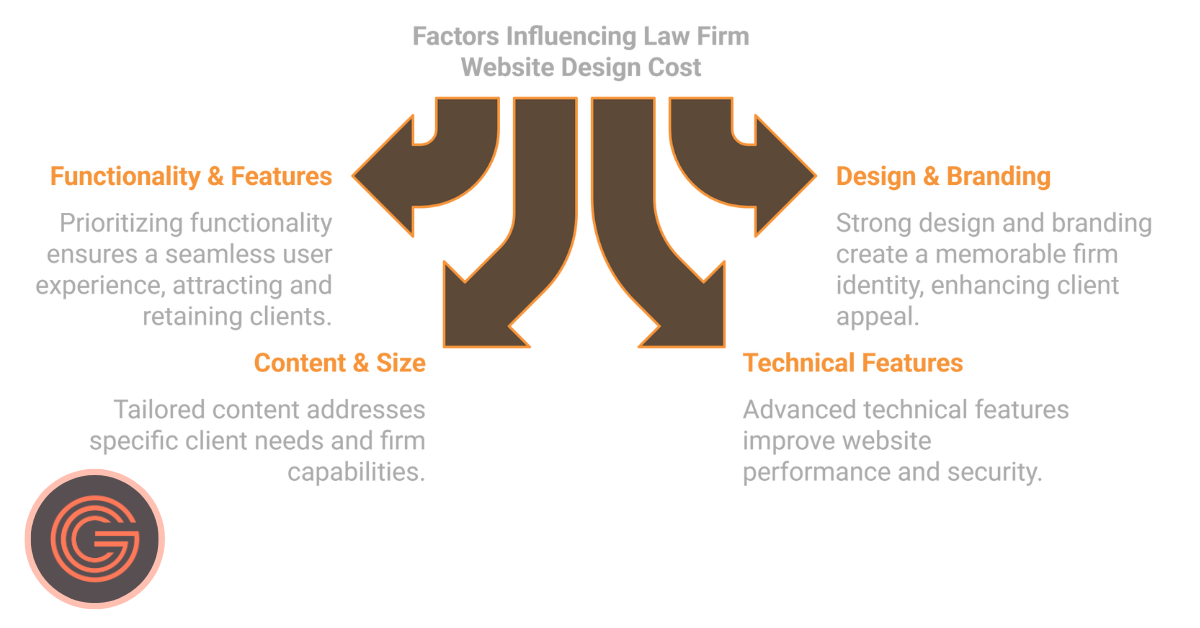
How Much Does Law Firm Website Design Cost?
A professional website is vital for law firms in 2025, with design costs ranging from $3,000 to $25,000 depending on complexity and features. Your law firm website design cost impacts how well your site builds trust, improves visibility, and attracts clients in today’s competitive market.
Investing in a website designer ensures your firm’s brand is presented professionally, offering features like custom solutions, advanced features, and search engine optimization to generate more clients. A well-designed site does more than look good—it is a critical tool for showcasing your legal expertise and generating leads.
At GLP Marketing, we craft tailored law firm websites that deliver measurable results. Whether you need local SEO, a basic website, or a fully custom site, we ensure your site presence is optimized for success. Contact us today to learn how we can elevate your firm’s online visibility.
This guide explores everything you need to know about law firm website design costs, from DIY platforms to high-end custom websites. We’ll break down the design process, factors influencing costs, and how to budget effectively for a top-tier website.
Why Law Firms Need a Professional Website

A professional legal site is more than a digital storefront—it’s a key driver of client trust, engagement, and differentiation in a competitive marketplace. Whether you’re looking to attract potential clients or solidify your brand, your website serves as the foundation of your legal marketing strategy.
First impressions matter, with 75% of users judging a firm’s credibility based on web design quality. A polished, professional website builds trust and sets the stage for meaningful client interactions, much like how essential resources—such as great books for lawyers—can elevate your firm’s expertise.
In today’s crowded legal market, a well-designed website also gives your firm a competitive advantage. By integrating advanced features like new client forms and search engine optimization (SEO), your site can stand out and attract the attention of potential clients.
Functionality is equally important, with elements like contact forms, mobile responsiveness, and client testimonials improving usability and streamlining communication. A high-quality website ensures your firm meets the expectations of modern audiences while maintaining a functional and visually engaging online presence.
How Much Does Law Firm Website Design Cost in 2025?
The overall cost of a law firm website in 2025 depends on your goals, required features, and level of customization. Balancing cost, quality, and functionality is crucial for success. Whether you’re on a tight budget or pursuing a high-end solution, the right choice aligns with your firm’s needs and client expectations while addressing key factors like user experience, SEO, and branding.
Low-Cost Options
DIY platforms like Wix, Squarespace, or WordPress templates are ideal for firms starting out or operating on tight budgets. These platforms are easy to use and include basic features like mobile-friendly designs and clear CTAs. However, limitations in customization and scalability can hinder growth.
- Estimated Costs – $500–$5,000
- Example – A solo practitioner may create a simple site with a Wix template featuring a home page, practice areas, and a contact form. While affordable, it might lack the advanced SEO optimization needed to rank in competitive markets.
Mid-Range Solutions
For firms ready to invest in a more polished and tailored presence, semi-custom websites built by professional designers or small agencies provide a solid middle ground. These solutions often include enhanced navigation, intuitive site structures, and branding elements that reflect your firm’s identity.
- Estimated Cost – $5,000–$15,000
- Example – A boutique firm can work with a small agency to create a website with a modern layout, custom photography, and a mobile-friendly design to deliver a stronger user experience without breaking the bank.
High-End Websites
High-end solutions are fully customized by specialized web design agencies and are designed to deliver top-tier quality and functionality. These websites incorporate advanced features such as scrolling home page news updates, client portals, SEO-optimized structures, and seamless integrations that cater to larger firms with complex needs.
- Estimated Costs – $15,000–$50,000+
- Example – A high-profile firm might invest in a custom site with features like AI-powered chatbots, interactive case intake forms, and a robust content hub to attract and engage clients.
Balancing cost, quality, and functionality is key to achieving measurable results. Whether you’re on a tight budget or pursuing a high-end solution, the best choice aligns with your firm’s needs and client expectations.
Regardless of budget, features like mobile-friendly design, easy navigation, and clear CTAs are essential for a user-focused experience, addressing client pain points while balancing budget, quality, and efficiency within the “iron triangle.”
Factors Influencing Law Firm Website Design Price

The price of website design depends on key elements that impact functionality and client appeal. Aspects such as web hosting and the expertise of a web designer play a critical role in creating a site that offers a seamless user experience while effectively representing your firm. These factors significantly affect costs and your firm’s potential to attract and retain clients:
Functionality and Features of an Attorney Website
Functionality and features are the ingredients of a high-performing attorney website. They define how your site serves clients, showcases your expertise, and supports your firm’s goals. Key elements include client portals for secure communication and document sharing, practice area pages that highlight your services in detail, mobile responsiveness to ensure seamless browsing across devices, and multimedia features like video testimonials to establish trust and credibility.
The cost of implementing these features depends on their complexity and scope, ranging from $100 to $5,000 or more. Basic enhancements like mobile-friendly design are cost-efficient but essential for improving accessibility and user experience. On the other hand, advanced tools such as custom intake forms or interactive practice area pages require a higher investment but deliver significant value.
For instance, a mobile-responsive site ensures clients can easily navigate your website on smartphones. Additional features that can elevate your site include:
- Live Chat – Enables instant communication, converting potential leads into clients.
- Email Capture Forms – Simplify collecting client information for follow-ups.
- Appointment Schedulers – Allow clients to book consultations directly online.
- Client Login Portals – Provide secure access to case updates and important documents.
Integrating the right features makes your website more than a digital presence—it transforms into a strategic tool for engaging potential clients, showcasing your expertise, and driving results. Investing in features that align with your firm’s goals ensures every dollar spent maximizes usability and impact.
Design and Branding of Your Law Firm
The cost of design and branding can range from a few hundred dollars to several thousand dollars, depending on factors like the type of design and the number of pages required. For instance, a template-based design may cost less but could limit customization options, while a custom-coded design allows for unique layouts and advanced features tailored to your firm’s brand. Investing in a custom logo design can also reinforce your firm’s identity and create a cohesive and polished look.
Key design and branding elements that impact costs include:
- Custom-coded Designs – Provide complete flexibility for unique branding and functionality, which is ideal for firms needing specialized features.
- Templated Designs – Offer a cost-effective solution but may lack differentiation in a crowded market.
- Logo Design – Establishes a recognizable identity and ensures consistency across your website and marketing materials.
- Visual Consistency – Includes color schemes, typography, and imagery that align with your brand to create a cohesive user experience.
For example, a custom-coded design with tailored branding can elevate your site’s professionalism and client appeal. Conversely, a template-based design might suffice for smaller firms on tighter budgets, provided it integrates well with their practice areas and target audience.
Content and Size of the Law Firm
The effectiveness and overall law firm website cost are significantly influenced by the content and the size of your firm. A well-organized site with engaging, informative content enhances user experience and positions your firm as a trusted authority in the marketplace.
The cost of content and site size can range from $500 to $5,000 or more, depending on factors like the number of pages, the depth of content, and the number of attorneys highlighted. For instance, a firm with multiple practice areas and attorneys may require additional pages to provide detailed service descriptions, team bios, and client resources, which increases the complexity and cost.
Key content and size elements that impact cost include:
- Number of Pages – Practice area pages, attorney bios, and FAQ sections ensure clients can find relevant information easily.
- Attorney Profiles – Highlighting each attorney’s expertise builds credibility and establishes trust.
- Service Descriptions – Clear, detailed explanations of your legal services help educate clients and optimize your search.
- Additional Resources – Blogs, case studies, and downloadable guides enhance your site’s value and provide ongoing engagement opportunities.
For example, a small firm may need a concise website with 10–15 pages focused on its core services, while a larger firm might require 50+ pages to cover extensive practice areas and team members. Determining how many pages you need on your attorney website depends on your size, desired custom features, services offered, and primary audience.
Technical Features

Technical features play a crucial role in the functionality and performance of your website, directly impacting user experience and the ability to attract and retain clients. Investing in advanced technical capabilities helps your website look professional and operate seamlessly to meet your specific needs. Key technical features include search engine optimization, integration with CRM systems, and advanced functionalities.
SEO is essential for improving your website’s visibility in online searches. By optimizing for relevant keywords, such as your practice areas and location, your site can attract more targeted traffic. For example, implementing local SEO strategies can help your firm appear prominently in search results for queries like “family law attorney near me.”
Furthermore, connecting your website to a CRM system streamlines lead management and client communication. Features like automated follow-ups and centralized data storage improve efficiency and help you maintain more direct communication with your clients. For instance, integrating with platforms like Clio Grow enables easy tracking of inquiries and simplifies client onboarding.
Finally, tools like client portals and appointment scheduling enhance usability and cater to client expectations. A client portal allows secure document sharing and case updates, while appointment scheduling tools enable clients to book consultations directly through your site, saving time for both parties. These features demonstrate your commitment to client convenience and professionalism.
The cost of technical features varies based on their complexity and integration requirements. For example, basic SEO implementation might cost a few hundred dollars, while building a robust client portal or integrating a CRM system can range into the thousands.
Hidden Costs to Keep an Eye On
While the upfront cost of a law firm’s website is important, hidden expenses can significantly impact your budget over time. These ongoing costs ensure that your site remains functional, secure, and effective at attracting clients and are essential for long-term success. Key hidden costs include:
| List of Hidden Web Costs | |
| Plugin Fees | Many websites rely on plugins for functionality, such as SEO tools, live chat, or appointment scheduling. While some plugins are free, premium versions can cost between $50 and $500 annually, depending on the features you need. |
| Domain Renewals | Your domain name must be renewed yearly, typically costing $10 to $50. Premium domains or additional extensions can increase this cost. |
| Ongoing Optimization | Routine updates to improve SEO, site performance, and user experience are crucial. Services like keyword updates, mobile optimization, and performance audits can cost between $500 and $5,000 annually, depending on the scope of work. |
| Website Maintenance | Routine maintenance, such as fixing bugs, updating software, and ensuring compatibility with browsers, can cost $100 to $500 per year or more, depending on the complexity of your site. |
| Hosting Fees | The quality of your web hosting affects your site’s speed, reliability, and security. Hosting plans can range from $5 monthly for basic options to $200 or more for dedicated hosting services. |
| Security | Protecting your site from cyber threats is critical. Costs for SSL certificates, firewalls, and malware monitoring typically range from $50 to $300 annually. |
| Content Updates | Regularly refreshing your content—such as blogs, service pages, and attorney bios—keeps your site relevant and engaging. This may result in an additional cost of $100 to $1,000 per update, depending on the scope of changes. |
For example, failing to renew your domain or update plugins can lead to downtime or vulnerabilities, negatively impacting your firm’s credibility. By planning for these expenses, you can maintain a high-performing website that continues to deliver value to your clients and supports your business goals.
3 Ways to Create a Law Firm’s New Website
Building a website requires an approach matching your goals, budget, and needs. Whether you choose a cost-effective DIY platform, a highly customizable design, or a legal-specific solution, understanding these options is essential to help you decide what works best for your firm.
1. DIY Website Builders
DIY platforms like WordPress and Wix are budget-friendly options for smaller law firms. Prices start at approximately $15 per month, making them ideal for firms with limited resources or simple website requirements.
| DIY Website Builder Pros & Cons | |
Pros:
| Cons:
|
A firm focused on a single practice area may benefit from using a template-based site with essential features like a basic contact form. However, firms with growth plans or multiple services may find this approach too restrictive as their needs evolve, requiring more scalable solutions.
2. Professional Website Agency
Hiring a professional website design agency, like PaperStreet, offers custom design and development tailored to your firm’s unique needs. Prices for a legal website cost typically start at $5,000, making this a mid-to-high investment option for firms seeking a competitive edge.
| Professional Agency Website Builder Pros & Cons | |
Pros:
| Cons:
|
To generate more clients through advanced SEO strategies, partner with a professional agency to rank for high-value terms like “personal injury attorney near me.” At GLP Marketing, we combine exceptional design with comprehensive local SEO to boost visibility, attract leads, and establish your firm as an industry authority. Let us create a site that delivers measurable results for your practice today.
3. Legal-Specific Website Builders
Platforms like Clio Grow and LawLytics are tailored specifically for law firms and offer specialized features to support legal practices. Prices typically start at around $1,000, providing a middle ground between DIY platforms and fully custom solutions.
| Legal-Specific Website Builder Pros & Cons | |
Pros:
| Cons:
|
For firms aiming to simplify client communication, platforms like Clio Grow are an excellent option. These tools include features like automated appointment scheduling and client management systems, streamlining operations while maintaining a professional client experience.
How to Budget for a New Law Firm Website

Budgeting for a new attorney website involves balancing your goals, must-have features, and ongoing expenses to maximize your investment. A strategic approach ensures your site meets your firm’s needs while staying within your financial means. Here’s how to create a realistic and effective budget:
- Define Your Goals – Clearly outline what you want your website to achieve. Do you need it to generate leads, showcase services, or provide detailed information for your clients? Identifying these objectives helps you prioritize features that align with your firm’s mission. A firm focused on lead generation, for instance, might emphasize SEO-friendly design and client intake forms, which directly contribute to converting website traffic into leads.
- Research Costs – Gather estimates for essential expenses like design, web hosting, domain registration, and ongoing maintenance. DIY platforms, such as WordPress, often cost less upfront and suit firms with simpler needs, while professional web design agencies require higher initial investments but offer fully customized solutions tailored to your goals. Understanding these additional cost tiers ensures you can choose an option that aligns with your needs and resources.
- Set a Realistic Budget – Allocate a budget range based on your law firm’s size and specific requirements. For smaller firms, a budget between $5,000 and $10,000 might suffice, whereas larger practices with multiple practice areas may require $15,000 or more. Balancing short-term affordability with long-term ROI ensures your investment supports client acquisition and enhanced visibility over time.
- Prioritize Features – Focus on high-impact features like mobile responsiveness, SEO, and easy navigation to deliver measurable results. A responsive design ensures seamless performance across devices and creates a better user experience. If your budget is limited, phase in less critical features over time while prioritizing essential elements that drive immediate impact.
- Allocate a Contingency Fund – Set aside 10–15% of your budget for unexpected expenses or upgrades. These could include integrating additional plugins or resolving unforeseen technical issues during development. Accounting for these contingencies ensures your project stays on track and avoids budget overruns.
- Plan for Ongoing Costs – Include recurring expenses such as maintenance, content updates, and SEO services in your budget. Regularly optimizing your website and keeping it secure ensures it remains competitive. For instance, monthly SEO services help maintain high rankings in search engine results, drive consistent traffic, and attract potential clients.
How to Choose the Right Web Design Partner
Selecting the right web design or marketing agency is a critical step in creating a good law firm website that aligns with your goals and serves your clients effectively. The right partner will not only build a professional and functional attorney website but also help ensure it meets the specific demands of the legal industry. Here’s how to find the best fit for your firm:
Step 1) Evaluate Experience – Look for a portfolio showcasing experience with legal firms. A marketing agency or custom design partner with a strong track record, like over a decade, in the legal space understands unique needs like practice area pages, compliance standards, and targeted SEO strategies.
Step 2) Check Expertise – Verify that the web designer offers services like SEO, mobile-friendly design, and user experience optimization. These elements are essential for improving visibility and usability. If your firm focuses on personal injury law, the partner should create a custom design that highlights trust and effectively converts leads while emphasizing your brand’s credibility.
Step 3) Review Testimonials – Read reviews, case studies, and client testimonials to gauge the partner’s reputation. Focus on agencies with a strong presence in the legal sector and positive feedback from law firms similar to yours. Testimonials that describe successful SEO strategies or seamless integration of advanced features can demonstrate the partner’s ability to deliver results.
Step 4) Assess Communication – Choose a partner who listens to your needs and responds promptly. Reliable partners offer regular updates and collaborative planning to keep the project on track. Effective communication is crucial for implementing features like appointment scheduling or live chat tools, so they meet both technical and user expectations without confusion.
Step 5) Discuss Budget Transparency – Request a detailed cost breakdown to avoid hidden fees. The best partners are upfront about all costs, even if it’s only a few dollars. If integrating client registration forms or other key features is a priority, confirm these are included in the quoted price.
Step 6) Ask About Post-Launch Support – Ensure the partner offers ongoing maintenance, updates, and troubleshooting. Post-launch support is vital for keeping your site competitive and functional. Partners who provide training for content management systems empower your team to handle basic updates and demonstrate a commitment to your firm’s long-term success.
By weighing these factors, you can select a website design agency that aligns with your goals and delivers a site that drives growth, enhances client experiences, and strengthens your online presence.
How to Generate More Leads with Web Presence?
A strong site presence is one of the most effective ways to generate leads and grow your law firm. Your website is the foundation for reaching potential clients, building trust, and converting visitors into leads. By leveraging proven strategies, you can stand out in the competitive marketplace and drive consistent growth. Learn more about lead generation strategies to enhance your firm’s online success.
Leverage Current Trends
Staying ahead of web design trends helps your attorney website remain relevant and engaging. Key trends include video introductions, ADA-compliance updates, and dark mode design.
Personalized videos on landing pages introduce your firm and establish a connection with visitors. For example, a brief welcome video from your managing attorney can humanize your brand and build trust.
Additionally, verify your site meets accessibility standards, broadens your audience, and avoids legal risks. Features like alt text for images and keyboard navigation show a commitment to inclusivity.
Finally, providing a dark mode option improves user experience for clients browsing at night or in low-light conditions, aligning with modern browsing preferences.
Improve Your Social Media
An active and engaging social media presence can drive traffic to your website while fostering trust with prospective clients. Platforms like Facebook and LinkedIn provide opportunities to share client success stories, legal insights, and case results. Posting a video that highlights a recent win not only demonstrates expertise but also engages your audience and sparks interest in your services.
Use Free Consultations
Offering free consultations is a proven way to turn website visitors into leads. Highlight a clear call to action encouraging visitors to schedule their consultation. An integrated booking form streamlines the process, prompting quick action and enhancing user convenience.
Create a Good Attorney Bio
Your attorney bio pages are among the most visited sections of your website. Each bio should highlight the attorney’s credentials, achievements, and personal story. Adding video testimonials from satisfied clients boosts credibility and gives potential clients confidence in their decision to hire your firm.
Show Social Proof

Social proof, such as client testimonials, case studies, and reviews, builds trust and reinforces your firm’s expertise. Display these elements prominently on your home page or service pages. A carousel of five-star reviews on your landing pages is a powerful endorsement and showcases your consistent track record of success and client satisfaction.
Need a Proven SEO Agency to Ensure a High-Quality Website?
Your law firm’s online presence is more than just a digital storefront—it’s a direct line to your target audience. A professional firm website improves website visibility, drives client engagement, and showcases your legal services effectively.
This blog covered the attorney website design cost landscape, from DIY platforms to custom websites. By investing in a professional design, you position your firm for long-term growth and success.
At GLP Marketing, we create best-in-class websites that help law firms achieve measurable results. From SEO integration to ongoing support, we ensure your web presence drives traffic and conversions. Contact us today to learn how we can elevate your firm’s online strategy.
Your success starts with a well-designed website. Let GLP Marketing help you stand out in the legal industry, attract new clients, and achieve your business goals in 2025 and beyond.
Law Firm SEO FAQs
What Is The Best Platform For Law Firm Websites?
The best platform depends on your needs and budget. DIY platforms like WordPress are cost-effective and customizable, while legal-specific builders like LawLytics offer tailored compliance and client management features. Firms needing advanced capabilities may benefit from professional agency services for fully custom designs.
How Much Should A Small Law Firm Budget For A Website?
Small firms should budget between $5,000 and $10,000 for a professional website, depending on the complexity and features. For instance, adding SEO services or custom practice area pages may increase costs but provide better client acquisition and visibility.
How Much Does It Cost To Maintain A Law Firm’s Website?
The overall cost of maintenance ranges from $500 to $5,000 annually and covers hosting, plugin updates, and security. Investing in ongoing SEO or routine content updates can further enhance the performance and ROI of your attorney website.
Do Legal Websites Need To Comply With ADA Accessibility Standards?
Yes, compliance with ADA standards is crucial to avoid legal risks and improve accessibility for all users. Features like keyboard navigation, alt text for images, and high-contrast design ensure your site is inclusive and meets industry expectations.
How Can I Determine If My Website Needs An Overhaul?
Signs that an attorney website may need an overhaul include outdated design, poor mobile performance, and declining traffic or leads. A site audit can reveal weaknesses, such as slow load times or ineffective SEO strategies, and help you decide on necessary updates.
SEO Marketing Agency
Our mission at GLP is to propel businesses to new heights with the highest level of SEO services